|

by Frank Jacobs
May 06, 2019
from BigThink
Website
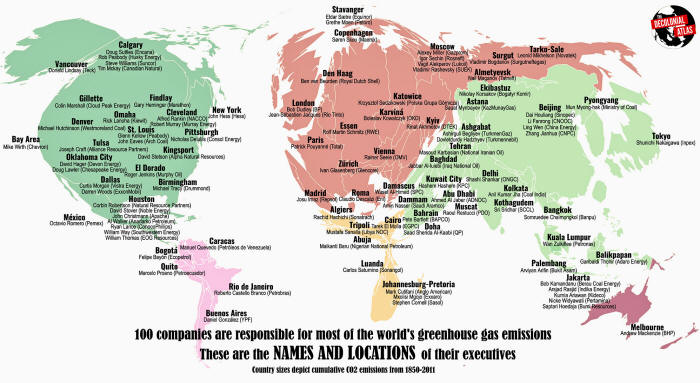
Names and Location of
the Top 100 People Killing the Planet
2019 - by Jordan Engel
Controversial map
names CEOs of
100 companies
producing 71
percent
of the world's
greenhouse gas emissions...
-
Just 100 companies produce 71 percent of the
world's greenhouse gases.
-
This map lists their names and locations, and
their CEOs.
-
The climate crisis may be too complex for these 100
people to solve, but naming and shaming them is a
good start.
Houston, we have a
problem...
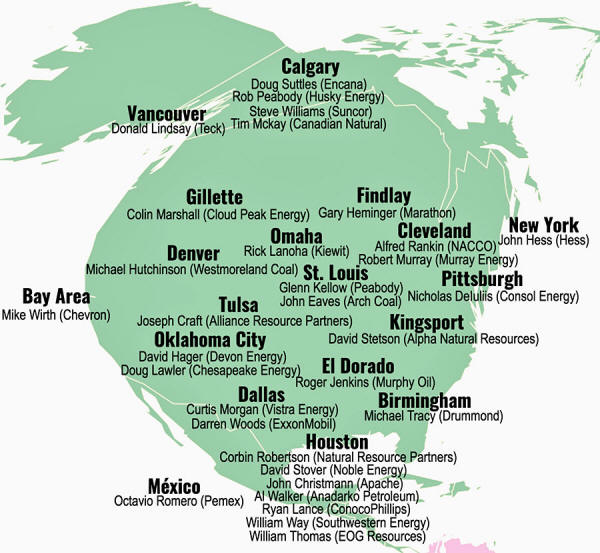
North American companies (and their CEOs)
most responsible for the emission of CO2
and other greenhouse gases.
Note the concentration of culprits in Houston.
Map
released by
The Decolonial Atlas
Do you carry your shopping home in a reusable bag? Close the tap
while you brush your teeth? Well done!
But saving the planet
will require a more systemic approach.
A
new UN-sponsored report (1,500
pages in full - consider the environment before printing!) details
how the accelerating decline of biodiversity is threatening
humanity's very survival.
It's not the first report of its kind, and despite their
increasingly alarmist tones, unlikely to be the last.
What to do?
Between the relative futility of individual do-goodery and the
seemingly unstoppable forces degrading earth's ecosystems lies a
whole world of despair, paralysis, and tuned-out apathy.
But if those forces seem unstoppable, it's perhaps because they
appear to be nameless and faceless. As this map points
out, they aren't. The harm that's being done to the
planet can be pinpointed, to a very specific list of companies...
And those companies have
CEOs that can be named and shamed.
The west vs.
the rest

The bigger the country, the bigger its share of CO2
emissions
since
the start of the Industrial Revolution.
Map
released by
The Decolonial Atlas
This map shows the 100 companies responsible for the biggest share
of the world's greenhouse gas emissions, and their CEOs.
Countries are inflated to
represent their share of CO2 emissions since the
beginning of industrialization.
If we want to make a serious dent in the amount of CO2
and other greenhouse gases we're emitting, this map suggests, it's
these companies - and more specifically, these CEOs -
we need to hold to account.
Naming and shaming them
is a first step...
The basis for this map is the
Carbon Majors report from 2017 by
CDP (formerly the Carbon Disclosure
Project), listing the top 100 fossil fuel producers in the world,
responsible for 71 percent of all greenhouse gas emissions since
1988.
In fact, more than 50 percent of all greenhouse gas emissions since
1988 can be traced to just the top 25 entities on that list.
Those are, in descending order:
-
China (state coal
production)
-
Aramco
-
Gazprom
-
National Iranian
Oil
-
ExxonMobil
-
Coal India
-
Pemex
-
Russia (state
coal production)
-
Shell
-
China National
Petroleum
-
BP
-
Chevron
-
PDVSA
-
Abu Dhabi
National Oil
-
Poland Coal
-
Peabody Energy
-
Sonatrach
-
Kuwait Petroleum
-
Total
-
BHP Billiton
-
ConocoPhilips
-
Petrobras
-
Lukoil
-
RioTinto
-
Nigerian National
Petroleum
The rogue's gallery
of Europe
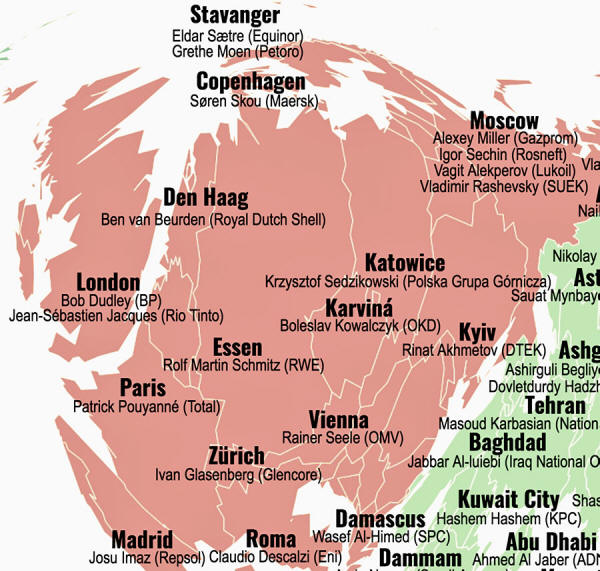
Even oil companies
are now turning to invest in sustainable energy
- but is it just window dressing?
Map
released by
The Decolonial Atlas
If fossil-fuel extraction over the next quarter century continues at
the same rate as the previous 25 years, the Carbon Majors report
claims we're on course for a 4°C rise in average temperatures by the
end of this century - accelerating the loss of biodiversity and the
rise of food insecurity, to name but two consequences.
Granted, even oil companies are aware that the wind is blowing from
a different direction now and have initiated programs to produce
energy in a more sustainable way.
But in many cases, the
discrepancy between the size of those programs and the attention
they are given in corporate PR makes them little more than window
dressing.
Jakarta beats
Beijing as emissions capital
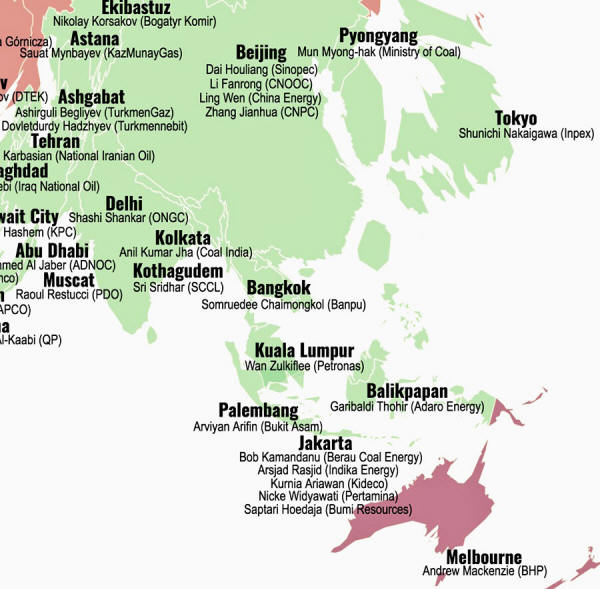
Jakarta, the capital of Indonesia,
is the
wider region's capital of greenhouse gas-emitting companies.
Map
released by
The Decolonial Atlas
This overview refocuses the attention on the main issue - the
emission of CO2 and other greenhouse gases. And by naming
each company's CEO, the issue is personalized.
That personalization should come with a few caveats.
First, these corporations thrive only because consumers buy their
product - although it must be said that demand for energy is fairly
inelastic: most people can't do without fuel to get from A to B, or
to heat their homes.
Second, in all fairness: the true captains of industry are not the
CEOs, but the majority shareholders. It's those shareholders'
priorities - profit only or planet also - that drive corporate
decision-making.
Those shareholders include large institutional investors, but also
national governments.
Up to 20 percent of
investment in hydrocarbon extraction is done by public funding -
i.e. us.
Clean
Africa, dirty Middle East
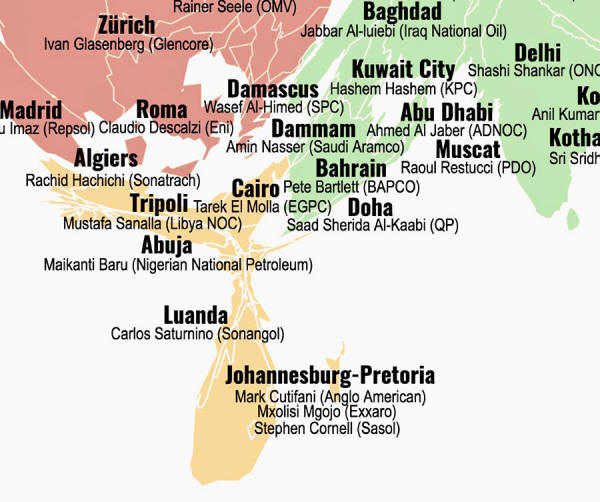
Africa counts relatively little CO2 culprits,
while the tally is much higher in the Middle East
(as could have been expected).
Map
released by
The Decolonial Atlas
On the other hand, we're running into the same problem mentioned
above again.
Big institutions, even if
they include you and me, are nameless/faceless. These CEOs are
picked to run and represent their companies. Perhaps they should get
used to a new job: being the lightning rod for our growing concern
about global warming.
The Decolonial Atlas, which published this map, quotes U.S.
folk artist and labor organizer Utah Phillips:
"The earth is not
dying, it is being killed, and those who are killing it have
names and addresses."
On that list is your name
and address, and mine; because we could all do a lot more. But not
nearly as much as these 100 people.
Let this map be an
invitation to acquaint ourselves with their intentions, good or
otherwise...
| 





